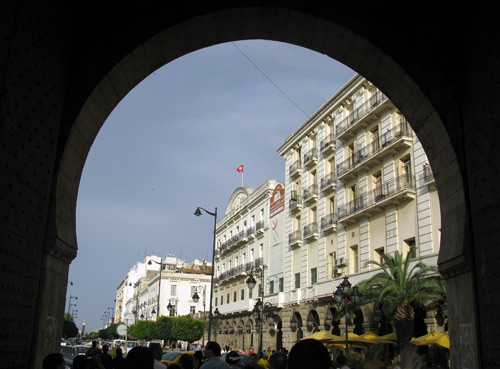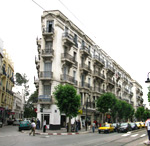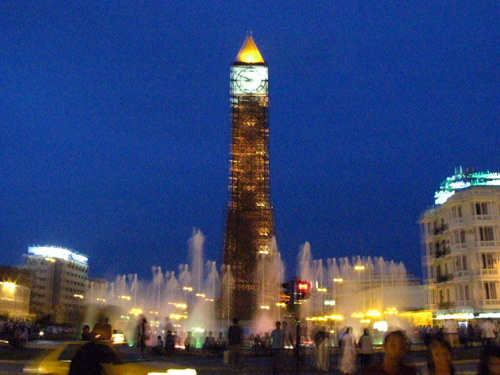
by Nathaniel Popkin
June 20, 2008
On Sunday I picked up the new reprint of The Algerine Spy in Pennsylvania, a funny little novel that illuminates early tensions between the United States and the
Muslim world. Published originally in 1787, during the closed-door Constitutional Convention, The Algerine Spy was written by Peter Markoe (known in the
cafés of Philadelphia as Peter the Poet), a polyglot born to a rich Hugenot family in St. Croix. Markoe was an Antifederalist, who worried that a strong federal
government would restrict the new nation's brilliant personal freedoms. He was particularly enamored of Pennsylvania's 1776 super-liberal constitution, its heightened
sense of anti-imperialism, and its unicameral legislature.
Markoe's protagonist is Mehemet, an Algerian selected by the despotic Osman Dey to go as a spy to the US. At the time, having caught two American ships off the coast of
Gibraltar, Algiers had taken twenty-one Americans hostage (it was thought for a time that Benjamin Franklin, en route from Paris to Philadelphia, was one of the
hostages). This was one of America's first foreign policy crises, and interestingly one that revealed the weakness of the original Confederation of states. America
couldn't afford the ransom demanded nor could it muster a military attack against Algiers.
But Markoe believed that America's strength was to be found in a virtuous freedom, which Mehemet encounters on the bustling, pluralistic streets of Philadelphia. There,
pretending to be from the south of France, he happily disappears into the crowd of people too busy with commerce to care if he is a Muslim, Christian, or Jew.
Ultimately, Mehemet is declared a traitor by the Dey and he renounces the Five Pillars of Islam for Pennsylvania "freedom, justice, friendship, and religion."
The American relationship with the Islamic states of Northern Africa took a few turns in subsequent years. In order to gain access to the shipping lanes of the
Mediterranean and to avoid further ransacking of American merchant ships, beginning in 1786, America signed treaties with Morocco, Libya (Tripoli), Algiers, and Tunis.
But in the first years of the 19th century, several more ships, including the USS Philadelphia, were taken and ransom demanded by the Dey and Pasha of Tripoli. Another
set of treaties were signed, ransom paid, and the sailors from the USS Philadelphia released, only to have more ships taken in 1807. Eventually, after the war of 1812,
the US Navy invaded Northern Africa, freeing the remaining merchant seamen.
And so it was that in Tunis the other day, taking a photograph at the intersection of Rue de Palestine and Rue de Jerusalem, a man driving a taxi stopped in front of me,
wagged his finger, and shouted threatening words. Perhaps still angered over that last Barbary war, he must have imagined I was a Pennsylvania spy in Tunis.
(Tunis has a benevolent despot for a president, a man who has ruled 21 years. There isn't freedom of press, nor is there complete freedom of speech or movement. It is
strictly prohibited to photograph government buildings, my indiscretion at the time. But Tunisians enjoy free health care and university education. The Tunisian
economy is open and forward-looking. Women have equal rights by law and some religious diversity is tolerated.)
In Tunis at times I felt like a spy. The confrontation with the taxi driver occurred right away, within the first few minutes of my initial foray into the city. It was
only a preview for the next few days. Later, I was questioned by police for wandering down a street in a nice neighborhood after dark, stopped and forced to reveal my
passport (and to claim, Je suis juif! over and over) after taking a photograph of what's probably the city's main synagogue. The guide for our group of students,
faculty, and staff from the University International Scholars Program at Philadelphia University checked in with police at every stop. The spy was being spied on, I
suppose.
Mehemet claims that "a Pennsylvanian was less known to us, than a Greenlander or a Chinese." To be sure, we might say the same of Tunisians, whose country is
overshadowed in our imagination by Libya and Egypt, Algeria and Morocco. But there is much for us here in Philadelphia to learn about and from Tunis, for it is a city
that has found a way to grow, testing new urban forms, while protecting its most ancient sections, among which is the oldest medina in the world.
French cities -- and Tunis was one for a time -- have benefited from a planning technique that allows a city to grow without demolishing and building over the old.
Critically, Haussmann ignored this technique when he built Paris's 19th century boulevards, but more modern planners have embraced it. In Paris this means the
contemporary corporate city La Defense was built outside of the central city, leaving it intact. In the northern city of Lille more recently, the adjacent
Koolhaas-designed Eurolille was built in stark contrast to the old. One form contrasts the other and each is allowed to follow particular symbiotic functions. In the
Moroccan city of Fez, the ville nouvelle was built adjacent to the medina. As in Tunis, the administrative center of the city moved there, but otherwise the old
city was left in its traditional labyrinthine form.
 French planners nearly forgot this principal when they planned the Tunis ville européenne in the 1920s. A Champs Éllysées was planned -- and
built -- from the eastern gate of the medina toward the Lac de Tunis. But planners initially wanted to extend the boulevard in the other direction from the Porte de
France through the medina to the gate opposite at the Kasbah, in effect eliminating chunks of the old city fabric, precisely as Haussmann had done to medieval Paris.
Happily, it didn't happen -- and now Tunis has three -- soon perhaps four -- visually and functionally separate cities: the medina, the ville européenne
(still the administrative center of the nation and filled with treasures of colonial architecture), the ville du lac (a contemporary city with wide streets,
apartment blocks, and corporate offices), and The Century City (Mediterranean Gate), a skyscraper city proposed and envisioned by investors from Dubai.
French planners nearly forgot this principal when they planned the Tunis ville européenne in the 1920s. A Champs Éllysées was planned -- and
built -- from the eastern gate of the medina toward the Lac de Tunis. But planners initially wanted to extend the boulevard in the other direction from the Porte de
France through the medina to the gate opposite at the Kasbah, in effect eliminating chunks of the old city fabric, precisely as Haussmann had done to medieval Paris.
Happily, it didn't happen -- and now Tunis has three -- soon perhaps four -- visually and functionally separate cities: the medina, the ville européenne
(still the administrative center of the nation and filled with treasures of colonial architecture), the ville du lac (a contemporary city with wide streets,
apartment blocks, and corporate offices), and The Century City (Mediterranean Gate), a skyscraper city proposed and envisioned by investors from Dubai.
The hope, of course, is that by building each new city, you not only leave the others intact, but you don't diminish them economically or socially. This has been a
challenge in American cities, where a place like King of Prussia very clearly diminishes central Philadelphia as much as it enhances it, and each new proposal feels in
the end like part of a zero-sum-game. In Tunis they put a check on this by enacting a preservation strategy for the medina in 1967 and attention is now being paid to
the ville européenne. The Association de Sauveguarde de la Médina de Tunis has twice won (in 1983 and 1995) the Aga Khan award for architecture in
the Arab world for the reconstruction of the Hafsia, the old Jewish quarter. When I asked the architect Sémia Akrout-Yaïche (pictured below), who directs
the medina preservation agency, why it was awarded the prize twice, she said it was for two things: reestablishment of the quarter as central to the economic and
commercial life of the city (and in doing so maintaining a balance between residential and commercial uses) and for the architecture itself, one that celebrates
traditional forms and materials without fetishizing them. Rather, forms are paired down to their essence and materials aren't mimicked, they're used. The result is a
contemporary architecture that enhances the feeling of the old around it.

Critically, too, the medina has not been allowed simply to gentrify. Allowances have been made to keep it a place of economic diversity.
What can we in Philadelphia learn from this? Foremost, we might allow ourselves to imagine a new city, one that's separate but symbiotic with the old. I'd put that new
city at the Navy Yard.
At the same time, we'll need a real neighborhood preservation strategy, one that thinks carefully about the forms and materials of the contemporary row house in context
of the old and one that encourages mixed uses and density. Our neighborhoods can be mini-economic centers again if density is allowed to be high enough to support
commercial uses. The modified suburban style of much neighborhood new construction achieves none of these goals, ultimately devaluing the neighborhoods. I'd like to
see the Design Advocacy Group turn its attention from ameliorating the Center City streetscape to imagining a new neighborhood architecture, one that's respectful of the
traditional form but also forward-looking and inspiring.
Can you imagine Philadelphia winning an international architectural award for the preservation of a neighborhood the size of Center City? I'm certain that a time not
long ago most Tunisians couldn't either. Regarding both a new city Navy Yard plan and a preservation plan, it will not hurt us to be ambitious. Ambition attracts
investment.
One last testimony from the Pennsylvania spy. Tunis' Champs Élysées is about the same length as our Benjamin Franklin Parkway. It too is punctured by a
traffic circle with an iconic fountain. But there are two differences. First, it is lined with cafés, hotels, and retail stores (and therefore it enjoys some
evening vitality). Second, the center of the avenue is for pedestrians, not cars. A few more cafés along the Parkway might address the first difference. The
second is both easier to achieve -- close the center car lanes -- and more difficult. It will take some political will. The payoff from trying to achieve what Tunis
already has would be a lasting change in the way we use our city.
Well then, meet me at the Tunis Café for pizza Neptune and a few puffs of the hookah? We'll watch carefree lovers saunter down the middle lane. I'll be the one
with the fake mustache and funny glasses.

–Nathaniel Popkin
|